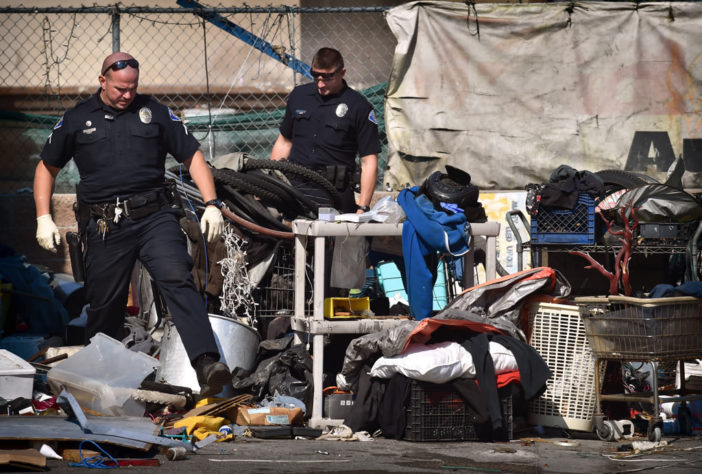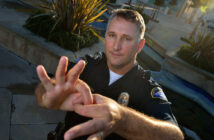A flood-control channel on Brookhurst Street in Garden Grove had become an underground refuge for homeless drug addicts, and with it, a mountain of debris and a litany of quality-of-life issues for the surrounding community — not to mention the denizens of the makeshift encampment themselves.
Today, an eight-foot high, tamper-proof fence surrounds the entrance to the county-owned channel, which is now free of people and trash.
Credit goes, in large part, to the efforts of the Garden Grove Police Department’s Special Resources Team (SRT).
A triangular patch of grass implanted with overgrown foliage, bordered by the 405 and 22 freeways and the 405 off-ramp to Garden Grove Boulevard, made for a well-camouflaged, albeit majorly unsafe, homeless encampment.
Once again, it was the department’s SRT unit that spearheaded a multi-agency effort to clear the area.
Today, the foliage has been trimmed and the area is free of inhabitants.
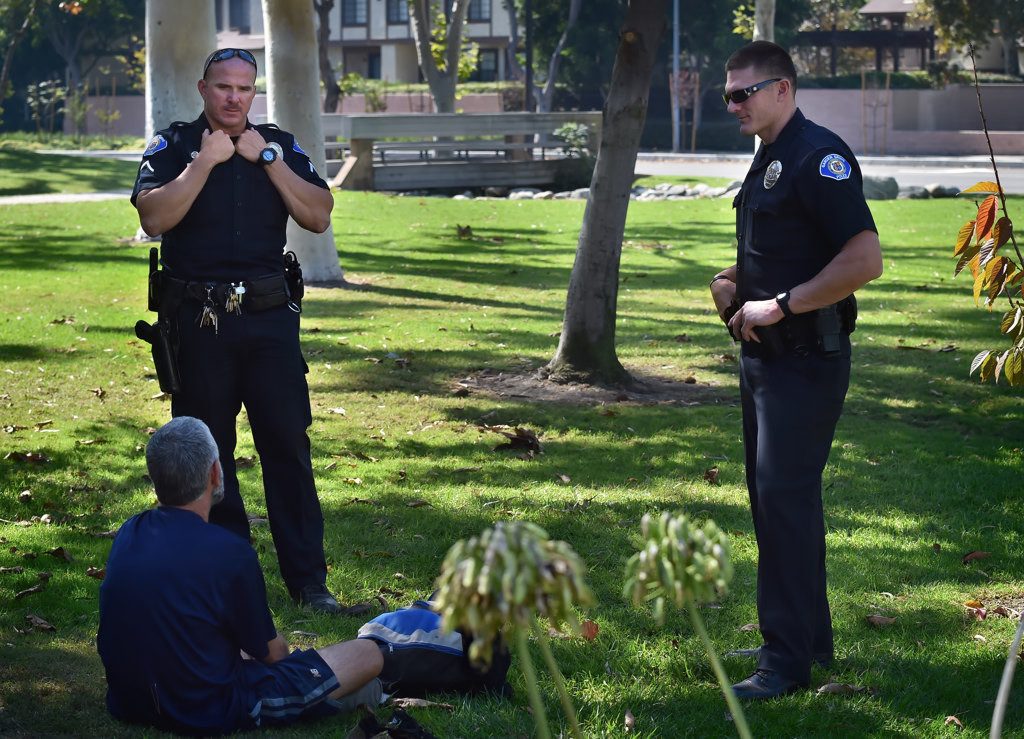
Garden Grove PD Officers Brian Hatfield, left, and Bryan Meers talk to a veteran outside the Garden Grove Library (across the street from Garden Grove High School) about services available to the homeless. Photo by Steven Georges/Behind the Badge OC
In 2016, 4 percent — or 3,000 — of the GGPD’s 72,000 calls for service involved disturbing-the-peace complaints, according to statistics provided by Lt. Carl Whitney. Most of those contacts were with homeless people.
The figures translate to an average of 8.2 calls for service per day.
The SRT unit was officially launched in May 2016.
In recent weeks, the GGPD has appointed two full-time officers, Brian Hatfield and Bryan Meers, to the team. Hatfield and Meers spend their entire 40-hour week dealing exclusively with issues related to homelessness.
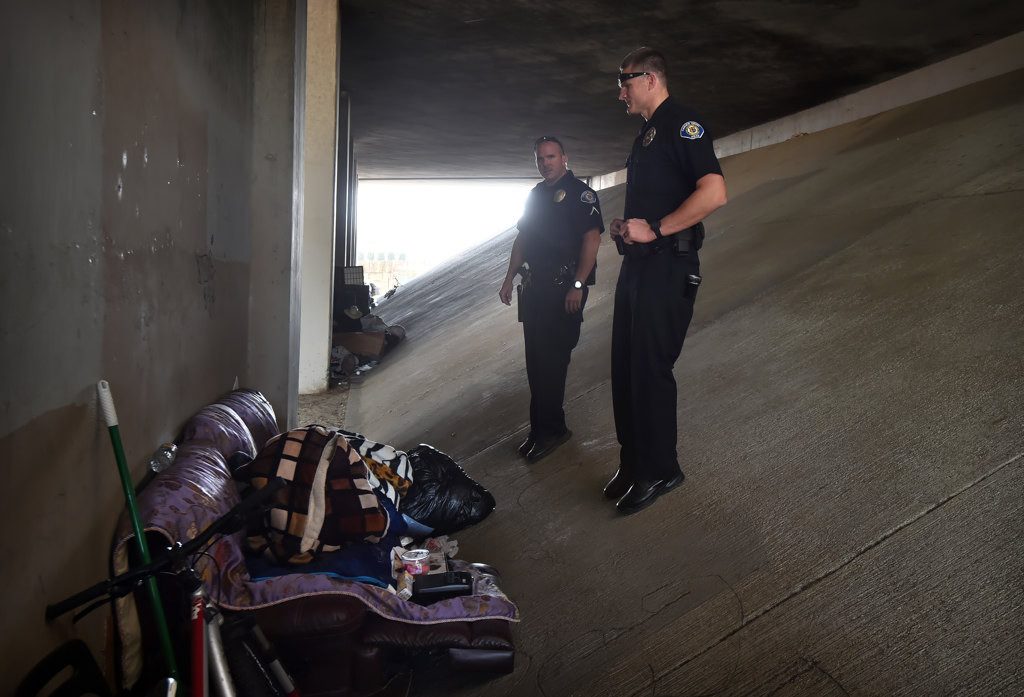
Garden Grove PD Officers Brian Hatfield, left, and Bryan Meers check on a man sleeping under an overpass of the Garden Grove (22) Freeway. Getting some people to accept services available to the homeless sometimes can be a struggle. Photo by Steven Georges/Behind the Badge OC
Other GGPD officers address homeless issues as part of their normal patrol duties.
At any given time, there are between 200 and 300 homeless people in the city, Hatfield said.
Having two officers devote all their time to taking on the burgeoning and complex issue of homelessness makes the small victories possible, said Hatfield, who began looking for ways to deal with the issue in 2015.
“All of these community problems can be resolved if you put the right people and enough resources toward them,” Hatfield said. “Homelessness is not a crime. Just because a person is homeless and on the street does not mean the police department can come make the person disappear.”
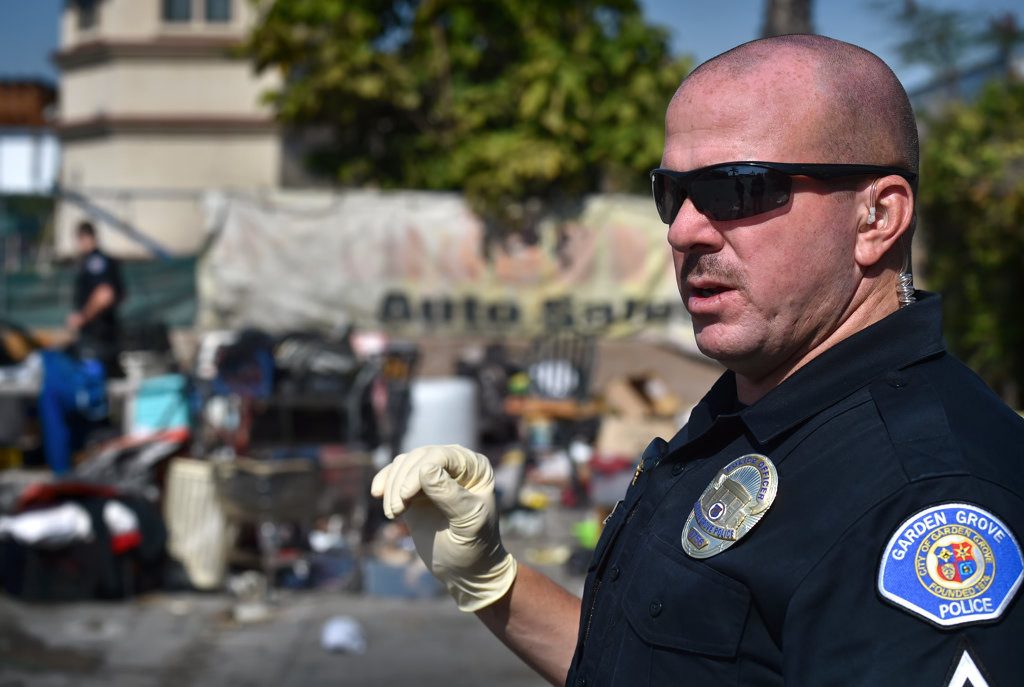
Garden Grove PD Officer Brian Hatfield talks about how some business properties can become magnets for trash left by the homeless. Photo by Steven Georges/Behind the Badge OC
Hatfield and Meers will be the first to tell you, however, that when one area gets cleaned up, an encampment often pops up nearby.
Meers and Hatfield recently cleared away a freeway underpass, only to see another nearby underpass become occupied by three transients.
A recently shuttered and abandoned carwash on Westminster Boulevard quickly became a blighted haven for the homeless.
A graffiti-stained building still stands on the piece of county-owned land, now carpeted with dismantled electronics, bicycle parts and other debris.

Garden Grove PD Officer Bryan Meers walks through the trash where an abandoned business has attracted some of the homeless. The place has become a nuisance to the other nearby businesses. Photo by Steven Georges/Behind the Badge OC
“It’s very common for neighborhoods in the surrounding areas to complain about bike thefts and then we come to places like this and see bicycle rims and parts and all these pieces all over the place,” Meers said.
But simply knowing where the homeless are won’t solve the problem, Hatfield said.
“I always look at why are they in this area?” Hatfield said. “What resources are they drawing from that are in this area? What restaurants are handing out free food? They are providing to the homeless population, which is fine but the concern comes … when two hours later, they are sitting on your front doorstep and you call us to tell them to leave.”
Meers and Hatfield advise against giving monetary handouts.
“What is helping a person succeed?” Hatfield said. “Is it providing that $5 out the window on a freeway offramp or would it be handing them the business card … for the county programs that are set up to catch people when they are in hard times and give that person the ability to move forward and provide a better life for themselves? That $5 is only going to help them for that brief moment.”
The goal of the SRT unit is not to chase the homeless from one spot to another, nor is the unit out to arrest transients.
That’s not even a second, third or fourth option, Meers said.
“The goal is not to put them into some kind of financial burden,” Meers said. “The goal is to alter behavior so they can assimilate back into the community, so they can make a positive influence or be a positive figure.”
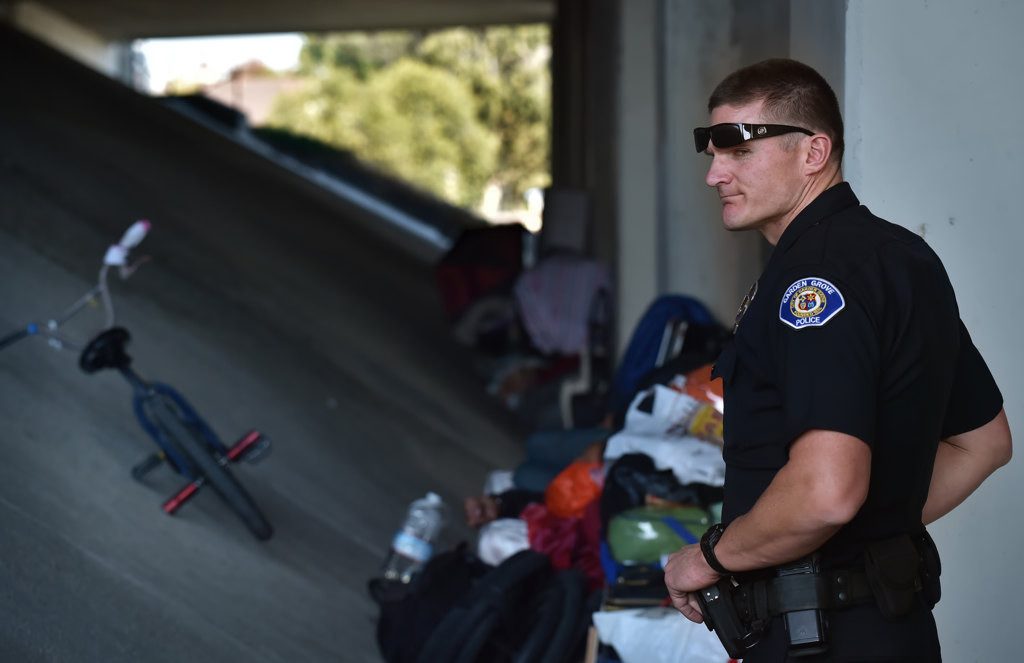
Garden Grove PD Officer Bryan Meers checks on some homeless people staying under the overpass of the Garden Grove (22) Freeway. Photo by Steven Georges/Behind the Badge OC
With virtually every homeless-related call, SRT officers hand out literature offering a variety of services — everything from substance-abuse help, mental health services and low-cost housing and shelter.
The SRT unit also brings along mental health professionals two days a week when making their rounds.
The GGPD also partners with CityNet, a nonprofit that provides services to the homeless.
Having ample assistance and aid available is great, Meers said.
But convincing the homeless to accept the help is a major challenge, he said.
“You can lead a horse to water only to watch it die at the trough,” Meers said. “These people have to want to help themselves.”
 Behind the Badge
Behind the Badge
